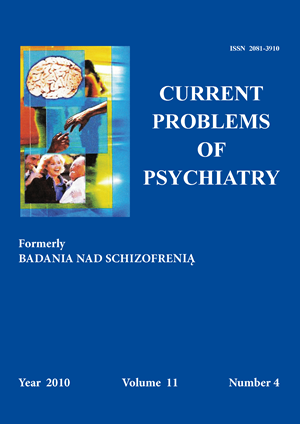Perpetrators of domestic violence – why do they use violence?Attempt to explain the phenomenon. Pilot studies
Keywords:
violence in a family, perpetrator of violence in a family, aggressionAbstract
Analysis of statistics on domestic violence indicates that over the past years this problem has been gradually increasing. Statistical data collected by the police indicate increased total number of households controlled by the police throughout the country. In order to identify the seriousness of the problem, we conducted research on men - the perpetrators of domestic violence. The study involved perpetrators of domestic violence - addiction clinic patients. In addition to intelligence tests, psychological interview, and psychological tools, for the purposes of this article, we used the results of Moods and Whims Scale, by Buss, Durkee, and socio-demographic survey of our own design.
The aim of our work is to detect relationships between perpetrators and the broad phenomena occurring in their generational families, and its impact on disclosure by perpetrators - of aggressive behavior. All the men included in the research confirmed that there was violence in their families. It was a physical and mental violence. The main perpetrator of violence according to the respondents and other family members, was the father. None of the men - the perpetrators of violence revealed that he had been molested as a child. However, all respondents reported physical punishment, meted out mostly by fathers, by hitting with a belt. Furthermore, the vast majority of men revealed an increase of aggressiveness in its various forms. It seems, therefore, that undertaking research in this area, to obtain information from the perpetrators of violence against a marked increase in magnitude, will contribute to a better understanding of this issue.
References
1. Kuczyńska S. Zrozumieć sprawców przemocy. Niebieska linia; Warszawa: 1999.
2. Pospiszyl I. Przemoc w rodzinie. WSiP; Warszawa: 1994.
3. Browne K., Herbert M. Zapobieganie przemocy w rodzinie, Państwowa Agencja Rozwiązywania Problemów Alkoholowych; Warszawa: 1999.
4. Kocur J, Rzeźniczak Ł. Analiza psychospołecznych uwarunkowań zachowań agresywnych w rodzinach. Post. Psychiatr. Neurol., 2002; 11(supl. 2), 15: 45-49.
5. Siek S. Wybrane metody badania osobowości. ATK; Warszawa: 1983.
6. Pilszyk A. Obraz psychopatologiczny sprawcy przemocy w rodzinie. Psych. Pol., 2007; XLI(6): 827-836.


